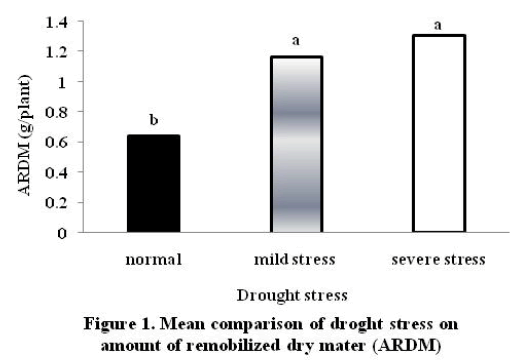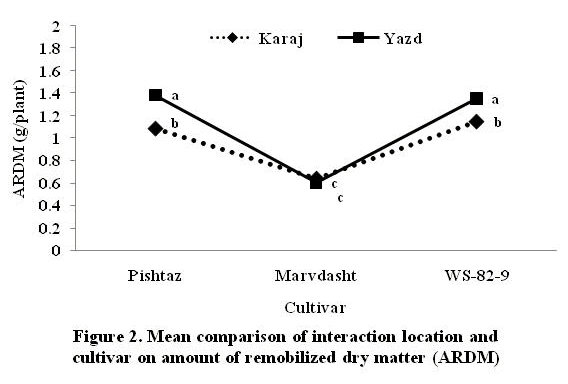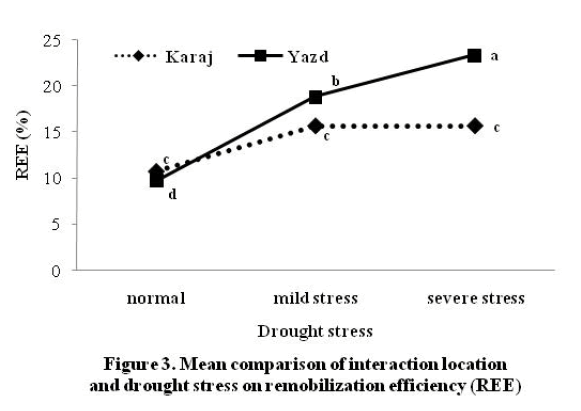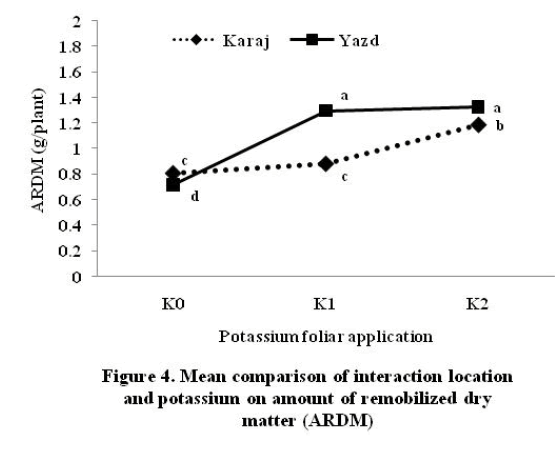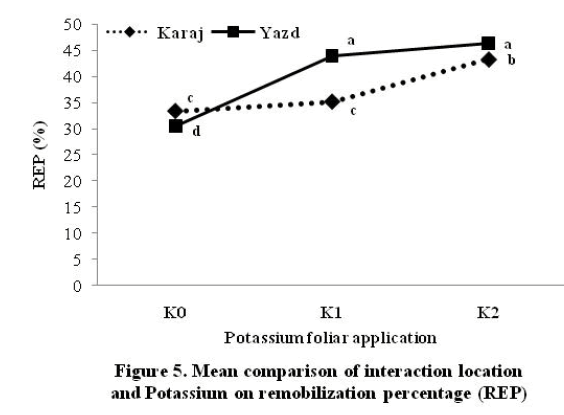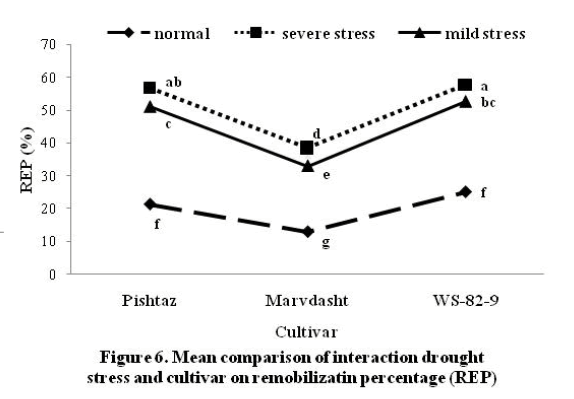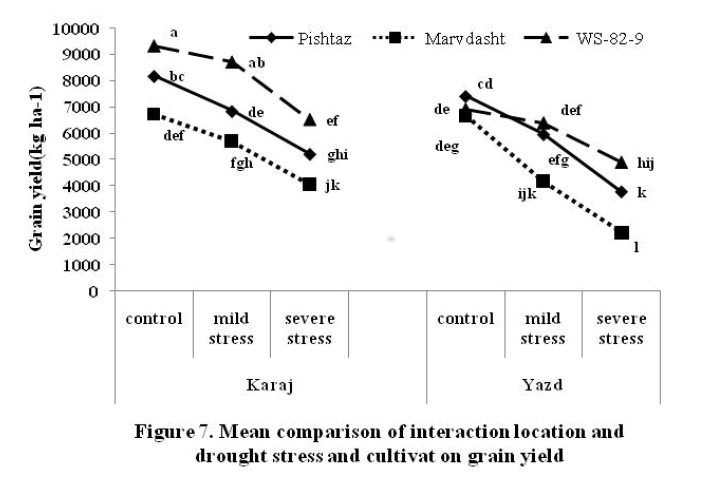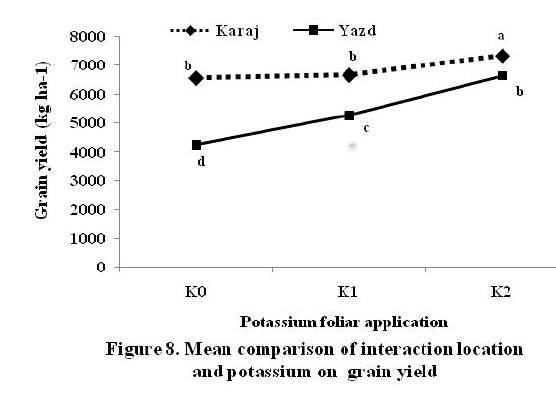Dry Matter Accumulation and Remobilization in Grain Wheat Cultivars under Drought Stress and Potassium Foliar Application Treatments
Abbas Zareian, Leila Yari, Seid Ali Tabatabaei
1Seed and Plant Certification and Registration Institute (SPCRI),Karaj,Iran
2Agricultural and Natural Resources Research Center of Yazd,Iran
- Corresponding Author:
- Abbas Zareian
Tel: +98(0)2632754071
Fax: +98(0)2632740333
E-mail: a_zareyan52@yahoo.com
Abstract
Two field experiments were conducted during growing season of 2011-2012 at two locations, 1. Seed and Plant Certification and Registration Research Institute (SPCRI), Karaj-Iran 2. Agricultural and Natural Resources Research Center, Yazd-Iran, to study dry matter accumulation and remobilization in grain wheat (Triticum aestivum L.) cultivars under drought stress and potassium foliar application treatments. The experiment was carried out using a split plot factorial based on a randomized complete blocks design with three replications. The experimental treatments included three irrigation regimes; normal, mild stress (water withhold at the seed filling phase) and severe stress (water withhold at the ear emergence phase); potassium foliar treatments included, 0, 1.5% and 3.0% K2O applications and three wheat cultivars (Marvdasht, Pishtaz and WS-82-9). The amount of remobilized dry matter (ARDM), remobilization efficiency (REE), remobilization percentage (REP) and grain yield were measured. The results showed that water stress significantly increased amounts of remobilized dry matter, remobilization efficiency and remobilization percentage compared with normal condition in both locations. However it significantly decreased grain yield. Foliar application of potassium at the rate of 3.0% K2O gave the highest values of all studied wheat characters followed by 1.5% K2O as compared with control treatment in both locations. Marvdasht cultivar had the lowest values of the above mentioned characters as compared with the two other cultivars.
Keywords
Wheat; Drought stress; Potassium foliar application; Remobilization percentage.
1. Introduction
Wheat is one of the main cereal crops,cultivated to meet great demands of the population for human feeding. It is the most important staple for bread flour in Iran [22]. The greatest fear of global climatic change is drought and among the environmental stresses,drought is one of the most severe stresses for plant growth and productivity [12]. Although,drought can affect all growth stages of wheat plant,seed filling is considered to be one of the most sensitive growth stages to water deficit stress [9]. Current photosynthesis as an important carbon source for grain filling is dependent on the effective light absorption by the green area of the plant after pollination stage. At the same time,demands for photosynthesis material for grain filling and for keeping respiration for live plant biomass increase [7]. In most studies on the small grain cereals,it was determined that stems and leaf sheaths contained most of the stored assimilates [13,28,31,33]. Papakosta and Gagianas [24] reported that stem reserves are important source of carbon for grain filling during terminal drought and remobilization percentage was 6 to %73 in bread wheat. During grain filling,occurrence of different biotic and abiotic stress factors such as water deficit decreases current photosynthesis [5]. Under this condition demand rate for utilization of the stem accumulation increases and remobilization of stem reserves is an important supporting process that can largely compensate grain yield decrease [23]. With increased drought stress greater remobilized dry matter,remobilization efficiency and remobilization percentage were determined in sorghum and wheat [6,17]. The response of a plant to environmental stress is determined by its nutritional status. One of the mechanisms for improving plant tolerance to drought is to apply K which seems to have a beneficial effect in overcoming soil moisture stress [20,27]. Increased application of K has been shown to enhance photosynthetic rate,plant growth and yield in different crops under water stress conditions [14,30]. Spraying wheat plants with K before subjecting the plants to drought treatment diminished the negative effects of drought on growth and in turn increases yield per plant [15].
The objective of this study was to find out the effects of drought stress and potassium foliar application on some physiological parameters such as amount of remobilized dry matter,remobilization efficiency and remobilization percentage and grain yield of three wheat cultivars.
2. Methods
Two field experiments were conducted in 2011- 2012 at two locations: 1- Seed and Plant Certification and Registration Research Institute (SPCRI),Karaj-Iran,2- Agricultural and Natural Resources Research Center,Yazd-Iran. Chemical and physical traits of experimental soil at both regions is representing in Table 1.

The experiment was carried out using a split plot factorial based on a randomized complete blocks design with three replications. Three irrigation regimes,control (normal irrigation),mild stress (water withhold at the seed filling phase) and severe stress (water withhold at the ear emergence phase),potassium foliar application,without foliar application (K0),1.5% K2O (K1) and 3.0% K2O (K2) and three wheat cultivars (Marvdasht,Pishtaz and WS-82-9) comprised the experimental factors. The amount of remobilized dry matter (ARDM),remobilization efficiency (REE),remobilization percentage (REP) and grain yield were measured. Seeds were sown on 15 and 19 November at Yazd and Karaj,respectively. Sowing density was 400 seeds m-2 by planting 500 seeds on each row. Plots were 5 m long and 2 m wide,with eight rows 0.25 m apart. All plants received irrigation until the imposition of treatments. Drought treatments imposed by withholding irrigation after ear emergence and seed filling phases. Plastic cover was used to prevent of effective rainfall on plots under drought water stress. Urea,potassium sulphate and super phosphate were applied according to results of soil analysis. All plots received one-third of urea and all super-phosphate at sowing. Other two-third of urea was applied at the start of stem elongation,and before flowering,respectively. Plots for potassium foliar application treatments were assigned to three levels of treatments i.e. control treatment (without spraying),1.5 and 3.0% K2O in the form of potassium sulphate (48% K2O). The foliar solution was prepared at both rates and applied using hand sprayer at steam elongation stage. In order to study the rate of remobilization of assimilates the dry weight of 20 randomly selected plants from each plot at the stages of anthesis and physiological maturity was obtained. Then the amount of remobilized dry matter (ARDM),remobilization efficiency (REE) and remobilization percentage (REP) were determined using the following equations [4,10,24].
ARDM (g/plant) = DMSHT (Ant) – DMSHT (Mat)
REE (%) = (ARDM (g/plant) / DMSHT (Ant)) × 100
REP (%) = (ARDM (g/plant) / GY (g/plant)) × 100 where,ARDM is amount of remobilized dry matter (g/plant);
DMSHT(Ant) is above-ground dry matter of plant parts at anthesis stage (g);
DMSHT(Mat) is above-ground dry matter of plant parts at maturity stage (g),except grain weight (g);
REE is remobilization efficiency (%);
REP is remobilization percentage (%); and GY is grain yield (g/plant).
The final harvest was done in a plot area of 3 m2 from the center of each plot for measuring grain yield.
Analysis of variance was carried out using SAS software. Treatment means were compared using Duncan's test at the 5% and 1% levels of significance and graph drawing was performed by means of Excel 2003 software. Bartlett test was used to test homogeneity of variances.
3. Results and Discussion
The results obtained from combined analysis of variance across two locations revealed significant difference (P<0.01) among different levels of drought stress,potassium foliar application,cultivars and their interactions (Table 2). Results indicated that drought stress significantly affected on amount of remobilized dry matter (Table 2). Remobilized dry matter was 0.63 and 1.30 g/plant in normal and severe water stress treatments,respectively (Figure 1). Mir taheri et al.,[21] in similar study on wheat reported that remobilized dry matter of drought stress treatment was %25 greater than control. These results are in line with those stated by Farhangi and Ghodsi [17],Davidson and Chevalier [11] and Yang et al. [31].
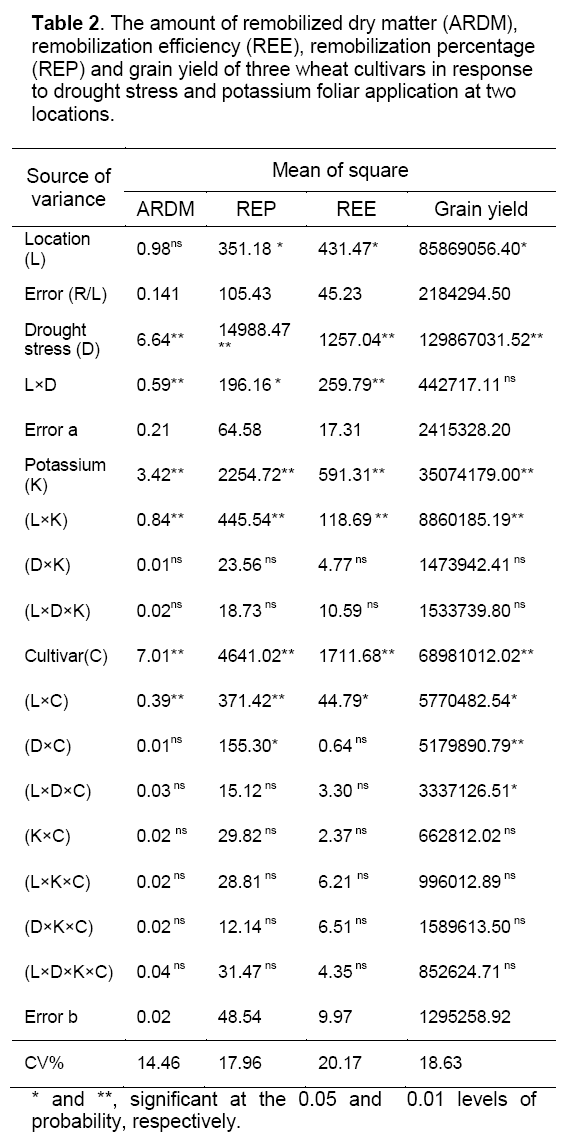
Interaction effects of location and cultivar on amount of remobilized dry matter was significant (Table 2). The lowest value of remobilized dry matter (0.6 g/plant) was observed in Marvdasht cultivar at both locations (Figure 2 ). It may be concluded that,difference among cultivars for this trait was due to their various genetic potential. Difference among wheat cultivars in this character was recorded by Mir taheri et al.,[21] who reported that under drought stress,high and low values of remobilized dry matter were obtained with Verinak (0.35 g/plant) and Shoeleh cultivars (0.04 g/plant),respectively.
Significant interaction effects of location and drought stress on remobilization efficiency showed that effects of drought stress was different at both locations. In this study maximum and minimum values of remobilization efficiency were found under severe stress (%23.35) and normal water use (%9.70) at Yazd,respectively (Figure 3 ). In similar study,result showed that drought stress caused %14.20 increase in remobilization efficiency as compared to normal condition [6].
Potassium foliar application significantly increased remobilized dry matter and remobilization percentage at both locations. Results showed that the efficiency of potassium fertilizer at Yazd was much more than Karaj. For example,differences between remobilized dry matter in highest level and no potassium application at Yazd was 0.22 g/plant more than Karaj. Also,high and low values of remobilization percentage were attained with spraying 3.0% K2O (%46.3) and no potassium application (%30.57) at Yazd,respectively (Figure 4 ,5). These increases may be ascribed to the role of potassium on increasing photosynthetic activity which accounts much for high translocation of photoassimilates from leaves to the grains. Numerous studies have shown that the application of potassium fertilizer mitigates the adverse effects of drought on plant growth in barley,sunflower,faba beans,sugar cane and rice that confirmed result of this study [1,3,19,27,29].
Significant interaction effects of drought stress and cultivar on remobilization percentage showed that reaction of cultivars under drought stress conditions was different. Results showed that highest remobilization percentage value was obtained with WS-82-9 under severe drought stress at Yazd (%52.74),while the lowest of remobilization percentage value was observed in Marvdasht cultivar under normal water use at Karaj (%12.96) (Figure 6 ). In similar study,Beheshti and Behboodi fard,[6] reported that drought stress caused %32.37 increase in remobilization percentage as compared with normal condition. The increase in remobilization of storage materials (carbohydrate) due to water stress during seed filling might have been due to the inhibition in photosynthesis efficiency under insufficient water conditions [5]. Under this condition demand rate for utilization of the stem accumulation increases and remobilization of stem reserves is an important supporting process that can largely compensate grain yield decrease [23]. Similar results have been reported by Papakosta and Gagianas [24]. Also,variation for this trait has been reported in different crop types that are in line with result of this study [8,18,24,28].
Interaction effects of location and drought stress and cultivar was significant on grain yield (Table 2). Results showed that reaction of cultivars under drought stress conditions at both locations was different. By increasing drought stress the reduction of grain yield was approximately similar in three wheat cultivars at Karaj,while under severe stress at Yazd,yield decrease with WS-82-9 than Marvdasht was least that can be associated to its physiological characteristics. The highest value of grain yield was produced with WS-82-9 under normal water use at Karaj (9310 kg ha-1),while the lowest value of grain yield was observed in Marvdasht cultivar under severe drought stress at Yazd (2220 kg ha-1) (Figure 7 ). This effect of water stress during grain filling on grain yield may be due to the reduction in rate and duration of filling processes and causing small grain size consequently reducing yield components (number of spikes per m2,number of grains per spike and 1000-grain weight). Similar results were detected by Pierre et al.,[25].
Potassium foliar application significantly increased grain yield at both locations. Results showed that the efficiency of potassium fertilizer at Yazd was much more than Karaj. For example,differences between grain yield in highest level and no potassium application at Yazd was 1616 kg ha-1 more than Karaj (Figure 8 ). Improvement in grain yield due to potassium foliar application may be ascribed to the role of potassium in improving many physiological growth processes and delay plant leaves senescence as well as increasing photosynthetic activity. These results are in line with those stated by Abou El-Defan et al. [2] and El-Sabbagh et al. [16].
4. Conclusion
Our results showed that drought stress significantiy affected on amount of remobilized dry matter (ARDM),remobilization efficiency (REE),remobilization percentage (REP) and grain yield. Potassium foliar application mitigates the adverse effects of drought on plant growth and improved remobilization of storage materials (carbohydrate). The highest increase in remobilization of storage materials was observed at Yazd area,because of unfavorable conditions (high temperature and low relative humidity) especially in May and Jun months that was at the same time with reproductive and grain filling phases of wheat. Marvdasht cultivar under drought stress condition attained the lowest remobilization of storage materials,indicating that this cultivar could sensitive drought stress as compared with the two other cultivars.
References
- Abdelvahab A. M.,Abdalla M. H.,(1995). The role of potassium fertilizer in nodulation and nitrogen fixation of faba beans (Vicia faba L.) plants under drought stress. J. Biol. Ferti Soils. 20: 147-150.
- Abou El-Defan T. A.,El-Kholi M. A.,Rifaat M. G. M.,et al.,(1999). Effect of soil and foliar application of potassium on yield and mineral content of wheat grains grown in sandy soils. Egyptian J. of Agric. Res.,77 (2): 513-522.
- Anderson M. N.,Jenson C. R.,Losch R.,(1992). The interaction effects of potassium and drought in field grown barley. 1. Yield,water use efficiency and growth. Acta Agricultureae Scandinavica. 42: 32-44.
- Arduini I.,Masoni A.,Ercoli L.,et al.,(2006). Grain yield,and dry matter and nitrogen accumulation and remobilization in durum wheat as affected by variety and seeding rate. Eur J Agron. 25: 309-318.
- Bdukli E.,Celik N.,Turk M.,et al.,(2007). ffects of post anthesis drought stress on the stem– reserve mobilization supporting grain filling of two rowed barley cultivars at different levels of nitrogen. J Bio Sci. 7: 949-953.
- Beheshti A. R.,Behboodi fard B.,(2010). Dry matter accumulation and remobilization in grain sorghum genotypes (Sorghum bicolor L. Moench) under drought stress. Australian Journal of Crop Science. 4 (3): 185-189.
- Blum A.,(1996). Improving wheat grain filling under stress by stem reserve utilization. In: Braun HJ,Altay F,Kronstas WE,Beniwal SPS,McNab A (eds). Prospects for global improvement. Proc. of the 5th Int. Wheat Conf. Ankara,Turkey,pp. 135-142.
- Bonnett G. D.,Incoll L. D.,(1992). Effects on the stem of winter barley of manipulating the source and sink during grain-filling 1. Changes in the composition of water-soluble carbohydrates of internods. J. Exp. Bot. 44: 75-82.
- Bradford K. J.,(1994). Water stress and the water relations of seed development: A critical review. Crop. Sci.,34:1-11.
- Cox M. C.,Qualset C. O.,Rains D. W.,(1986). Genetic variation for nitrogen assimilation and translocation in wheat. III. Nitrogen translocation in relation to grain yield and protein. Crop Sci. 26: 737-740.
- Davidson D. J. Chevalier P. M.,(1992). Storage and remobilization of water-soluble carbohydrates in stems of spring wheat. Crop Sci. 32:186-190.
- Deng X.,Shan L.,Inanaga S.,et al.,(2004). Water – saving approaches for improving wheat production. J. of the Sci. of Food and Agric.,85 (8): 1379-1388.
- Dubois D.,Winzeler M.,Neuberger J.,(1990). Fructan accumulation and sucrose: Sucrose fructosyltransferase activity in stem of spring wheat genotypes. Crop Sci.,30: 315-319.
- Egilla,J. N.,Davies F. T.,and Drew M. C.,(2001). Effect of potassium on drought resistance of Hibiscus rosa-sinensis cv. Leprechaun: Plant growth,leaf macro and micronutrient content and root longevity. Plant and Soil. 229(2): 213-224.
- El-Ashry M. S.,El-Kholy M. A.,(2005). Response of wheat cultivars to chemical desiccants under water stress conditions. J. of Appl. Sci. Res.,1 (2): 253-262.
- El-Sabbagh A. A.,Abd El-Hafez S. A.,El-Bably A. Z.,et al.,(2002). Response of wheat crop to irrigation intervals and foliar application of potassium. J. Agric. Res. Tanta Univ.,28 (4): 525-538.
- Farhangi S. Ghodsi M.,(2011). The contribution of remobilization of storage materials in wheat yield as affected by potassium iodide (KI). International Journal of Plant Physiology and Biochemistry . 3(3): 60-63.
- Kumudini S.,Hume D. J.,Chu G.,(2002). Genetic improvement in short-season soybeans: II. Nitrogen accumulation,remobilization,and partitioning. Crop Sci. 42:141-145.
- Lindhauer M. G.,(1985). Influence of K+ nutrition and drought on water relations and growth of sunflower. Z. Pflanzenernahr. Bodenk. 148: 654-669.
- Marchner H.,(1995). Mineral nutrition of higher plants. Second Edition,Academic press,London.
- Mir taheri S. M.,Siadat A.,Najafi M. S.,et al.,(2010). Effect of drought stress on remobilization of storage materials in five wheat cultivars. Iranian Journal of Field Crops Research. 8(2): 308-314.
- Nour-Mohamadi G.,Siadat A.,Kashani A.,(2009). Agronomy,Vol. 1: Cereal crops. Shahid Chamran University press. Iran-Ahwaz. pp.446.
- Palta J. A.,Kobata T.,Turner N. C.,et al.,(1994). Remobilization of carbon and nitrogen in wheat as influenced by postanthesis water deficits. Crop Sci. 34:118-124.
- Papakosta D. K.,Gagianas A. A.,(1991). Nitrogen and dry matter accumulation,remobilization and losses for Mediterranean wheat during grain filling. Agron. J. 83: 864–870.
- Pierre C. S.,Peterson C. J.,Ross A. S.,et al.,(2008). Wheat grain quality changes with genotype,nitrogen fertilization,and water stress. Agron. J.,100: 414-420.
- Reddya A. R.,Chaitanya K. V.,Vivekanandanb M.,(2004). Drought-induced responses of photosynthesis and antioxidant metabolism in higher plants. J. Plant Physiol. 161: 1189-1202.
- Royo C.,Blanco R.,(1999). Use of potassium iodide to mimic drought stress in triticale. Field Crops Res.,59: 201-212.
- Slafer G. A.,Savin R.,(1994). Sink-source relationships and grain mass at different positions within the spike in wheat. Field Crops Res. 37: 39-49.
- Sudama S.,Tiwari T. N.,Srivastava R. P.,et al.,(1998). Effect of potassium on stomatal behavior,yield and juice quality of sugarcane under moisture stress condition. Indian. J. Plant Physiol. 3: 303-305.
- Tiwari H. S.,Agarwal R. M.,Bhatt R. K.,(1998). Photosynthesis,stomatal resistance and related characters as influenced by potassium under normal water supply and water stress conditions in rice (Oryza sativa L.). Indian Journal of Plant Physiology. 3(4): 314-316.
- Wardlaw I. F.,Willenbrink J.,(1994). Carbohydrate storage and mobilization by the Culm of wheat between heading and grain maturity: the relation to sucrose synthase and sucrose-phosphate synthase. Aust. J. Plant Physiol.,21: 255-271.
- Yang J.,Zahang J.,Huang Z.,et al.,(2000). Remobiliztion of carbon reserves in improved by controlled soil-drying during grain filling of wheat. Crop Sci.,40: 1645-1655.
- Yang D. L.,Jing R.,Chang X. P.,et al.,(2007). Identification of quantitative trait loci and environmental interactions for accumulation and remobilization of water-soluble carbohydrates in wheat (Triticum aestivum L.) stems. Genetics. 176: 571-584.

Open Access Journals
- Aquaculture & Veterinary Science
- Chemistry & Chemical Sciences
- Clinical Sciences
- Engineering
- General Science
- Genetics & Molecular Biology
- Health Care & Nursing
- Immunology & Microbiology
- Materials Science
- Mathematics & Physics
- Medical Sciences
- Neurology & Psychiatry
- Oncology & Cancer Science
- Pharmaceutical Sciences
